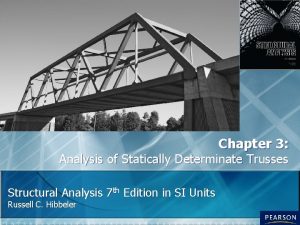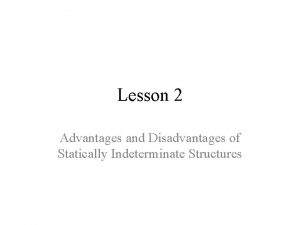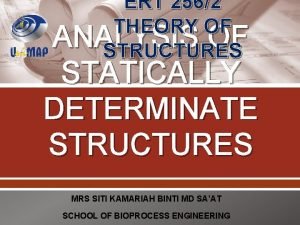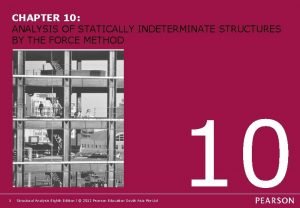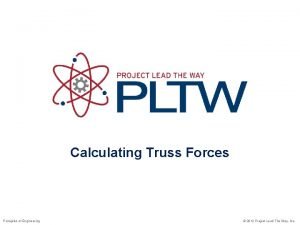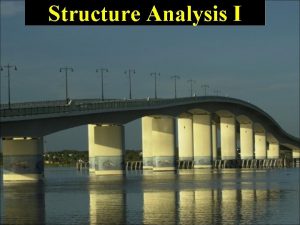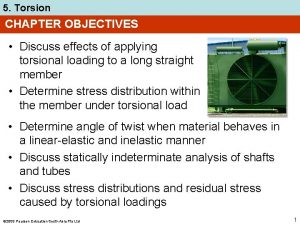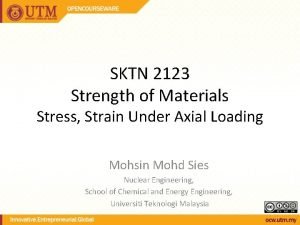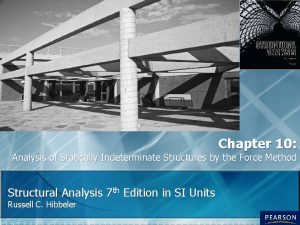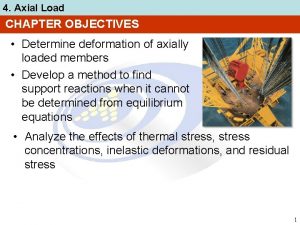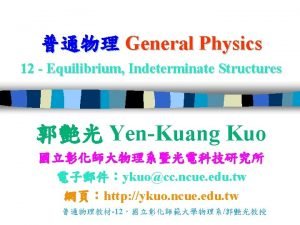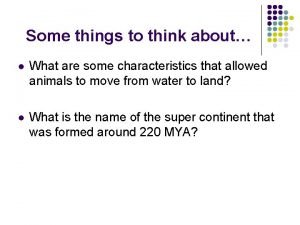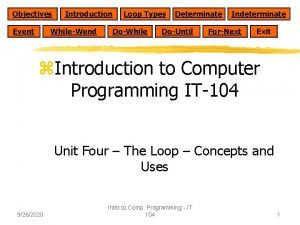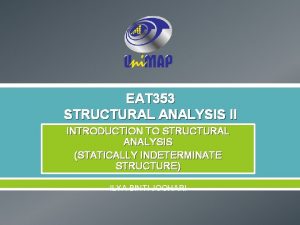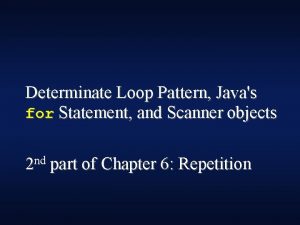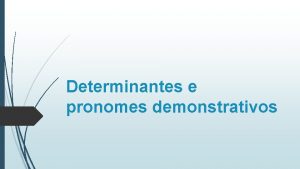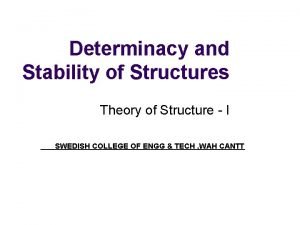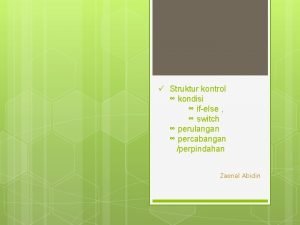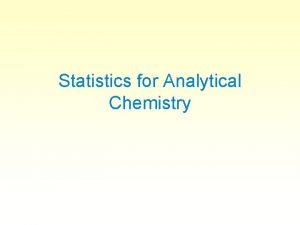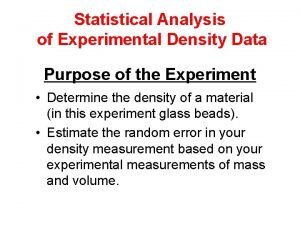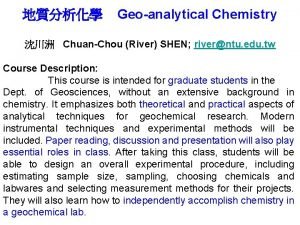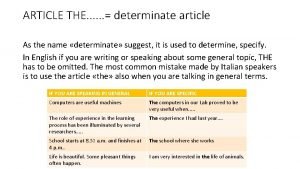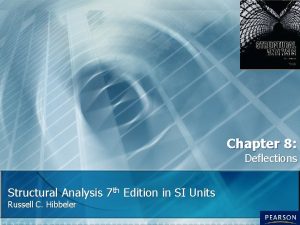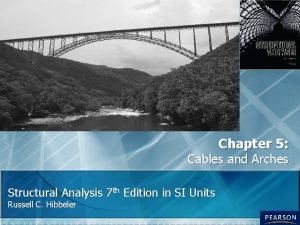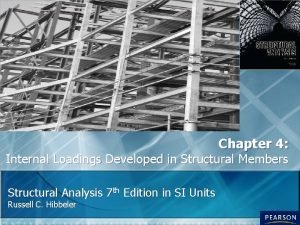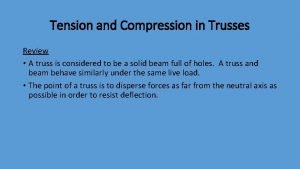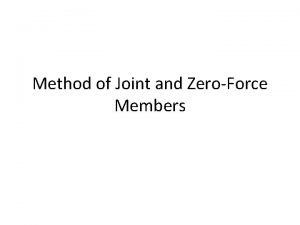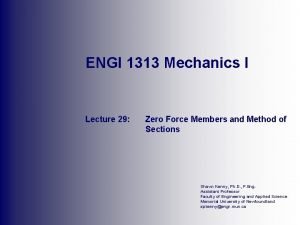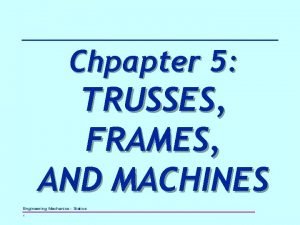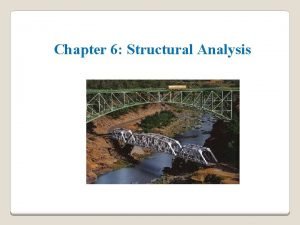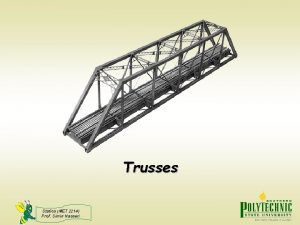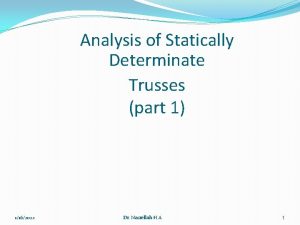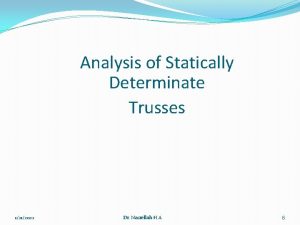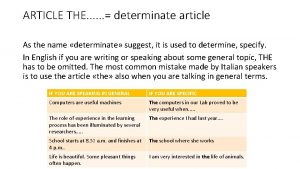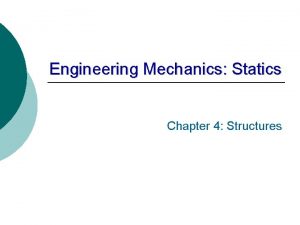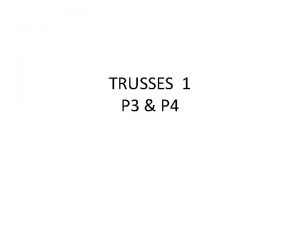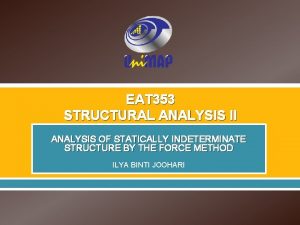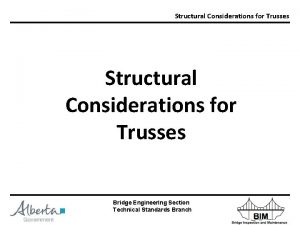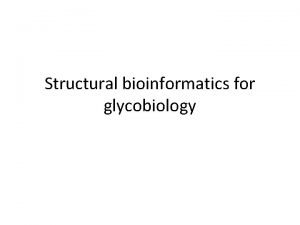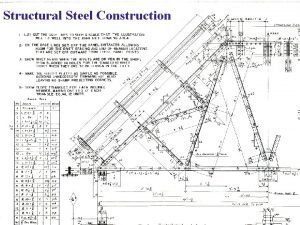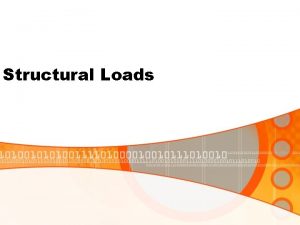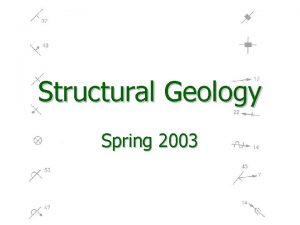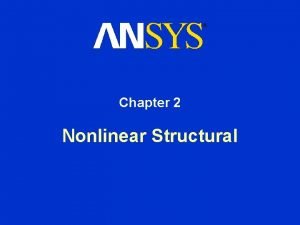Chapter 3 Analysis of Statically Determinate Trusses Structural








































- Slides: 40

Chapter 3: Analysis of Statically Determinate Trusses Structural Analysis 7 th Edition in SI Units Russell C. Hibbeler

Common Types of Trusses • A truss is a structure composed of slender members joined together at their end points • The joint connections are usually formed by bolting or welding the ends of the members to a common plate called gusset plate Chapter 3: Analysis of Statically Determinate Trusses Structural Analysis 7 th Edition © 2009 Pearson Education South Asia Pte Ltd

Common Types of Trusses • Roof Trusses • Scissors – short spans • Howe and Pratt – moderate span (18 m to 30 m) • Fan and Fink – (>30 m) Chapter 3: Analysis of Statically Determinate Trusses Structural Analysis 7 th Edition © 2009 Pearson Education South Asia Pte Ltd

Common Types of Trusses • Bridge Trusses • Pratt, Howe and Warren – span <60 m • Parker – span >60 m Chapter 3: Analysis of Statically Determinate Trusses Structural Analysis 7 th Edition © 2009 Pearson Education South Asia Pte Ltd

Common Types of Trusses • Assumptions for Design • The members are joined together by smooth pins • All loadings are applied at the joints • Due to the 2 assumptions, each truss member acts as an axial force member Chapter 3: Analysis of Statically Determinate Trusses Structural Analysis 7 th Edition © 2009 Pearson Education South Asia Pte Ltd

Classification of Coplanar Trusses • Trusses can be classify into 3 classes • Simple , • Compound • Complex Truss Chapter 3: Analysis of Statically Determinate Trusses Structural Analysis 7 th Edition © 2009 Pearson Education South Asia Pte Ltd

Classification of Coplanar Trusses • Compound and Complex Truss Chapter 3: Analysis of Statically Determinate Trusses Structural Analysis 7 th Edition © 2009 Pearson Education South Asia Pte Ltd

Classification of Coplanar Trusses • Determinacy • Therefore only • By comparing the total unknowns with the total no. of available equilibrium eqn, we have: Chapter 3: Analysis of Statically Determinate Trusses Structural Analysis 7 th Edition © 2009 Pearson Education South Asia Pte Ltd

Classification of Coplanar Trusses • Stability • If b + r < 2 j => collapse • A truss can be unstable if it is statically determinate or statically indeterminate • Stability will have to be determined either through inspection or by force analysis Chapter 3: Analysis of Statically Determinate Trusses Structural Analysis 7 th Edition © 2009 Pearson Education South Asia Pte Ltd

Classification of Coplanar Trusses • Internal Stability • The internal stability can be checked by careful inspection of the arrangement of its members • If it can be determined that each joint is held fixed so that it cannot move in a “rigid body” sense wrt the other joints, then the truss will be stable • A simple truss will always be internally stable • If a truss is constructed so that it does not hold its joints in a fixed position, it will be unstable or have a “critical form” Chapter 3: Analysis of Statically Determinate Trusses Structural Analysis 7 th Edition © 2009 Pearson Education South Asia Pte Ltd

Classification of Coplanar Trusses • Internal Stability • To determine the internal stability of a compound truss, it is necessary to identify the way in which the simple truss are connected together • The truss shown is unstable since the inner simple truss ABC is connected to DEF using 3 bars which are concurrent at point O Chapter 3: Analysis of Statically Determinate Trusses Structural Analysis 7 th Edition © 2009 Pearson Education South Asia Pte Ltd

Classification of Coplanar Trusses • Stability • External Stability • A structure is externally unstable if all of its reactions are concurrent or parallel • The trusses are externally unstable since the support reactions have lines of action that are either concurrent or parallel Chapter 3: Analysis of Statically Determinate Trusses Structural Analysis 7 th Edition © 2009 Pearson Education South Asia Pte Ltd

Example 3. 1 Classify each of the trusses as stable, unstable, statically determinate or statically indeterminate. The trusses are subjected to arbitrary external loadings that are assumed to be known & can act anywhere on the trusses. Chapter 3: Analysis of Statically Determinate Trusses Structural Analysis 7 th Edition © 2009 Pearson Education South Asia Pte Ltd

Solution For (a), • • • Externally stable Reactions are not concurrent or parallel b = 19, r = 3, j = 11 b + r =2 j = 22 Truss is statically determinate By inspection, the truss is internally stable Chapter 3: Analysis of Statically Determinate Trusses Structural Analysis 7 th Edition © 2009 Pearson Education South Asia Pte Ltd

Solution For (b), • • • Externally stable b = 15, r = 4, j = 9 b + r = 19 >2 j Truss is statically indeterminate By inspection, the truss is internally stable Chapter 3: Analysis of Statically Determinate Trusses Structural Analysis 7 th Edition © 2009 Pearson Education South Asia Pte Ltd

Solution For (c), • • • Externally stable b = 9, r = 3, j = 6 b + r = 12 = 2 j Truss is statically determinate By inspection, the truss is internally stable Chapter 3: Analysis of Statically Determinate Trusses Structural Analysis 7 th Edition © 2009 Pearson Education South Asia Pte Ltd

Solution For (d), • • Externally stable b = 12, r = 3, j = 8 b + r = 15 < 2 j The truss is internally unstable Chapter 3: Analysis of Statically Determinate Trusses Structural Analysis 7 th Edition © 2009 Pearson Education South Asia Pte Ltd

The Method of Joints • In all cases, the joint analysis should start at joint having at least one known force and at most two unknown forces. Chapter 3: Analysis of Statically Determinate Trusses Structural Analysis 7 th Edition © 2009 Pearson Education South Asia Pte Ltd

Example 3. 2 Determine the force in each member of the roof truss as shown. State whether the members are in tension or compression. The reactions at the supports are given as shown. Chapter 3: Analysis of Statically Determinate Trusses Structural Analysis 7 th Edition © 2009 Pearson Education South Asia Pte Ltd

Solution Only the forces in half the members have to be determined as the truss is symmetric wrt both loading & geometry, Chapter 3: Analysis of Statically Determinate Trusses Structural Analysis 7 th Edition © 2009 Pearson Education South Asia Pte Ltd

Solution Chapter 3: Analysis of Statically Determinate Trusses Structural Analysis 7 th Edition © 2009 Pearson Education South Asia Pte Ltd

Solution Chapter 3: Analysis of Statically Determinate Trusses Structural Analysis 7 th Edition © 2009 Pearson Education South Asia Pte Ltd

Zero-Force Members • Truss analysis using method of joints is greatly simplified if one is able to first determine those members that support no loading • These zero-force members may be necessary for the stability of the truss during construction & to provide support if the applied loading is changed • The zero-force members of a truss can generally be determined by inspection of the joints & they occur in 2 cases. Chapter 3: Analysis of Statically Determinate Trusses Structural Analysis 7 th Edition © 2009 Pearson Education South Asia Pte Ltd

Zero-Force Members • Case 1 • If only two non-collinear members form a truss joint and no external load or support reaction is applied to the joint, the members must be zero-force members. Chapter 3: Analysis of Statically Determinate Trusses Structural Analysis 7 th Edition © 2009 Pearson Education South Asia Pte Ltd

Zero-Force Members • Case 2 • Zero-force members also occur at joints having a geometry as joint D • Three members form a truss joint for which two of the members are collinear, the third member is zero -force member provided no external load or support reaction at the joint.

Zero-Force Members • Case 2 • No external load acts on the joint, so a force summation in the y-direction which is perpendicular to the 2 collinear members requires that FDF = 0 • Using this result, FC is also a zero-force member, as indicated by the force analysis of joint F Chapter 3: Analysis of Statically Determinate Trusses Structural Analysis 7 th Edition © 2009 Pearson Education South Asia Pte Ltd

Example 3. 4 Using the method of joints, indicate all the members of the truss that have zero force. Chapter 3: Analysis of Statically Determinate Trusses Structural Analysis 7 th Edition © 2009 Pearson Education South Asia Pte Ltd

Solution We have, Chapter 3: Analysis of Statically Determinate Trusses Structural Analysis 7 th Edition © 2009 Pearson Education South Asia Pte Ltd

Solution Chapter 3: Analysis of Statically Determinate Trusses Structural Analysis 7 th Edition © 2009 Pearson Education South Asia Pte Ltd

The Method of Sections • If the forces in only a few members of a truss are to be found, the method of sections generally provide the most direct means of obtaining these forces • This method consists of passing an imaginary section through the truss, thus cutting it into 2 parts • Provided the entire truss is in equilibrium, each of the 2 parts must also be in equilibrium Chapter 3: Analysis of Statically Determinate Trusses Structural Analysis 7 th Edition © 2009 Pearson Education South Asia Pte Ltd

The Method of Sections • The 3 eqns of equilibrium may be applied to either one of these 2 parts to determine the member forces at the “cut section” • A decision must be made as to how to “cut” the truss • In general, the section should pass through not more than 3 members in which the forces are unknown Chapter 3: Analysis of Statically Determinate Trusses Structural Analysis 7 th Edition © 2009 Pearson Education South Asia Pte Ltd

The Method of Sections • If the force in GC is to be determined, section aa will be appropriate • Also, the member forces acting on one part of the truss are equal but opposite • The 3 unknown member forces, FBC, FGC & FGF can be obtained by applying the 3 equilibrium eqns Chapter 3: Analysis of Statically Determinate Trusses Structural Analysis 7 th Edition © 2009 Pearson Education South Asia Pte Ltd

The Method of Sections • When applying the equilibrium eqns, consider ways of writing the eqns to yield a direct solution for each of the unknown, rather than to solve simultaneous eqns Chapter 3: Analysis of Statically Determinate Trusses Structural Analysis 7 th Edition © 2009 Pearson Education South Asia Pte Ltd

Example 3. 5 Determine the force in members CF and GC of the roof truss. State whether the members are in tension or compression. The reactions at the supports have been calculated. Chapter 3: Analysis of Statically Determinate Trusses Structural Analysis 7 th Edition © 2009 Pearson Education South Asia Pte Ltd

Solution The free-body diagram of member CF can be obtained by considering the section aa, Chapter 3: Analysis of Statically Determinate Trusses Structural Analysis 7 th Edition © 2009 Pearson Education South Asia Pte Ltd

Solution The free-body diagram of member GC can be obtained by considering the section bb, Chapter 3: Analysis of Statically Determinate Trusses Structural Analysis 7 th Edition © 2009 Pearson Education South Asia Pte Ltd

Example 3. 6 Determine the force in member GF and GD of the truss. State whether the members are in tension or compression. The reactions at the supports have been calculated. Chapter 3: Analysis of Statically Determinate Trusses Structural Analysis 7 th Edition © 2009 Pearson Education South Asia Pte Ltd

Solution The distance EO can be determined by proportional triangles or realizing that member GF drops vertically 4. 5 – 3 = 1. 5 m in 3 m. Hence, to drop 4. 5 m from G the distance from C to O must be 9 m Chapter 3: Analysis of Statically Determinate Trusses Structural Analysis 7 th Edition © 2009 Pearson Education South Asia Pte Ltd

Solution The angles FGD and FGF make with the horizontal are tan-1(4. 5/3) = 56. 3 o tan-1(4. 5/9) = 26. 6 o Chapter 3: Analysis of Statically Determinate Trusses Structural Analysis 7 th Edition © 2009 Pearson Education South Asia Pte Ltd

Solution Chapter 3: Analysis of Statically Determinate Trusses Structural Analysis 7 th Edition © 2009 Pearson Education South Asia Pte Ltd
 Analysis of statically determinate trusses
Analysis of statically determinate trusses Statically determinate truss
Statically determinate truss Unstable structures
Unstable structures Advantages and disadvantages of determinate structures
Advantages and disadvantages of determinate structures Improperly constrained
Improperly constrained Advantages of indeterminate structures
Advantages of indeterminate structures Statically determinate truss
Statically determinate truss Statically determinate
Statically determinate Single pitch roof truss design
Single pitch roof truss design Triple roof
Triple roof Approximate method of structural analysis
Approximate method of structural analysis Internal torque equation
Internal torque equation Statically indeterminate axially loaded member
Statically indeterminate axially loaded member Advantages and disadvantages of indeterminate structures
Advantages and disadvantages of indeterminate structures St venant principle
St venant principle Statically indeterminate beam fixed at both ends
Statically indeterminate beam fixed at both ends Spiral and determinate cleavage
Spiral and determinate cleavage Determinate and indeterminate loop in vb
Determinate and indeterminate loop in vb Indeterminate structures
Indeterminate structures Determinate loop
Determinate loop Pronomes demonstrativos variaveis
Pronomes demonstrativos variaveis Stability and determinacy of structures
Stability and determinacy of structures Determinate loop
Determinate loop Switch merupakan struktur perulangan.
Switch merupakan struktur perulangan. Differentiate between determinate and indeterminate error
Differentiate between determinate and indeterminate error Determinate and indeterminate errors
Determinate and indeterminate errors Dnyansadhana college
Dnyansadhana college Differentiate determinate and indeterminate errors
Differentiate determinate and indeterminate errors Compara forma adjectivului gri cu forma adjectivului alb
Compara forma adjectivului gri cu forma adjectivului alb Determinate article
Determinate article Care sunt adjectivele propriu zise
Care sunt adjectivele propriu zise Deflection
Deflection Arches
Arches Structural analysis chapter 4 solutions
Structural analysis chapter 4 solutions Tension and compression in trusses
Tension and compression in trusses Members of truss with zero force
Members of truss with zero force Feature trusses
Feature trusses Zero force members in trusses
Zero force members in trusses Determine the force in each member of the truss.
Determine the force in each member of the truss. Applications of trusses
Applications of trusses Trusses statics
Trusses statics

